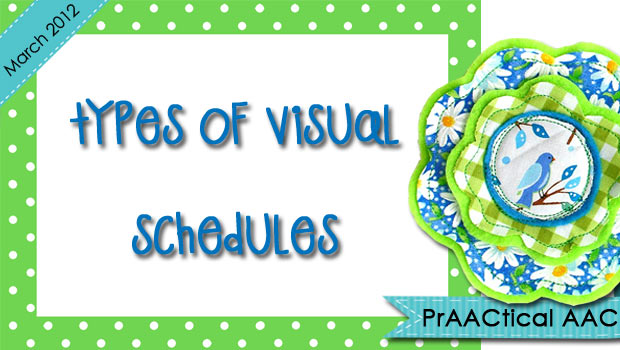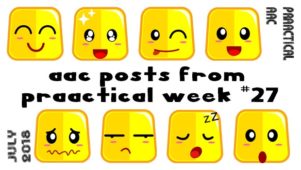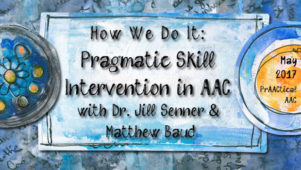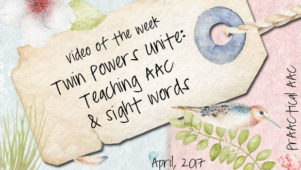Strategy of the Month: Types of Visual Schedules

When people think about visual schedules, they tend to think about a classroom schedule with PCS for each major activity of the day. These are great and we look for them whenever we do classroom visits. In this post, we hope to inspire some of you to use other types of visual schedules as well. We haven’t quite worked out the right terms for these (and we welcome your suggestions) but, conceptually we know that there are three main levels of visual schedules. Each level conveys information about what is happening in a specific segment of time.
–
At the Calendar Level, the schedule represents what’s happening throughout the month and/or week.
–/SET_BC_April_calendar.png)
At the Schedule Level, we’re representing the events of a particular day, a portion of a day, or a session (or class period).
–
At the Task Level, the schedule reflects discrete steps of an activity or task.
–
Each of these can be used at home and school (or work). The different levels of visual schedules work together to provide a solid system of support that the person can depend on for information. Knowing that lies ahead helps all of us prepare ourselves and allows us to maximize our internal resources. Let’s look at an example.
–
Chloe is a determined young lady with significant intellectual disabilities and autism. At home, her mom keeps a big visual calendar on the refrigerator and a smaller weekly calendar on a nearby wall with some of Chloe’s other visual supports. The monthly calendar shows which are school days, which are home days (mostly weekends), and when special events are occurring. Chloe can see at a glance that, unlike December, with all its trips and celebrations, this will be a ‘normal’ month. She can easily see the pattern of when she’ll be going to school and when she’ll be staying home. Pictures of her respite care worker and cousin mark the days when those people will be visiting. The weekly calendar has a bit more detail, showing when there are planned afterschool activities (e.g., gym, shopping with a personal care worker, library with her brothers).
–
Chloe also has a schedule for the afternoon and evening hours, a hectic time for many families. When she comes home, Chloe is helped to check the afterschool schedule to preview what’s in store for the rest of the day: have a snack, relax with some leisure time activities, set the table for dinner, eat, outside for a bit of exercise and fresh air, etc.
–
On this particular day, she has also homework: not a favorite for anyone in her house. Usually, the homework tasks are predictable, so the SLP has made mom a number of symbols that go along with each of Chloe’s assignments. What works well for this family is to have mini schedules for each of those tasks, so that Chloe has a visual representation of what she is expected to do. Today, however, there is a new type of assignment and mom doesn’t have time to go make a symbol for it. With Chloe by her side, mom grabs a sticky note, draws a rough symbol (she’s no artist), and writes the name of the activity on the top telling her daughter what’s going to happen as she writes. It’s not perfect, but it is better than nothing and, because she’s done this many times before, Chloe tolerates it fairly well.
–
–/SET_BC_Weekly_Schedule.png)
What should I do if I am working with a child and don’t have a symbol I need? Once in awhile there are changes that we didn’t anticipate. Whether it is a fire drill that you just found out about, a sudden errand that you have to run, or some other unplanned event, you know that the day will run smoother if there is a way to add it to the schedule. We’ve found two ways of handling this that make sense to the kind of learners with whom we work.
–
Option 1: Make a symbol on the fly by quickly writing out the name of the activity and, if possible, sketching out a quick symbol. No artistry needed, a rough sketch is fine. Because you are doing this in front of the learner and talking through the process while you make the symbol, the verbal explanation paired with the visual helps more often than we first expected. In fact, many of our AAC friends have surprised us over the years with their ability to make use of these handmade symbols.
–
Option 2: Develop a symbol that you can use for any unexpected or unplanned event. Pick some visually distinctive and abstract, such as an asterisk. Abstraction is fine since a) it isn’t possible to represent the unknown in concrete way, and, b) the longitudinal work by Romski and Sevcik with people who have intellectual disability demonstrated their capacity to learn and use abstract symbols. Whenever something irregular is going to happen, use this abstract symbol to represent it.
–
What if the person doesn’t want to do the activity or step on the schedule?
Schedules are not choice boards. We use them to help the learner understand what will be happening, not control it. On the other hand, we want to respect learners’ preferences and build in autonomy where we can.
–
What’s a poor clinician to do?
–
Here are some things to consider.
1. If I let the learner decide not to do what is on the schedule, confusion reigns. “Oh, I guess I don’t have to do that if I don’t want to. Well, then…What does the schedule mean?” Think of the schedule as a rule, and once we start bending the rules, it becomes less clear for the learner.
–
2. If the activity is something that has to be done, then it’s time to grin and bear it. Use the visual supports to get through it quickly and calmly. Then move onto the next activity which, hopefully, is something more enjoyable for the learner.
—/SET_BC_Written_Schedule.png)
Are there ever times when we let the learner make choices in a schedule? Yes. Here’s an idea of how that might work
1. Begin and end with anchor activities that are non-negotiable (e.g., Hello song, Goodbye song).
2. or the remaining activities, have a selection of activities from which the learner can choose. One caveat: Make sure that you’re prepared with all of the activity and AAC materials for the choices that you are offering. Don’t offer any choices for activities that you aren’t prepared to lead. If you don’t have Candyland set and ready to go, don’t make that one of the things the learner can choose from.
3. As the learner chooses the activities for that session, place it on the schedule.
4. Once the schedule is set, consider going over it with the learner. “First, we’ll sing our Hello Song, then we’ll read a book, then we’ll do our story map, then…”
–
Using schedules and calendars makes life easier for people who use AAC and helps our therapy activities run more smoothly. Keep individualizing them for the learners you serve. We’d love to hear your ideas for creative approaches to making schedules that work.
–
Thanks to SET BC for the use of the visuals schedules depicted in this post. Visit them at www.setbc.org/SET_BC_HS_Schedule.png)
Filed under: Strategy of the Month
Tagged With: intervention, visual schedule
This post was written by Carole Zangari




